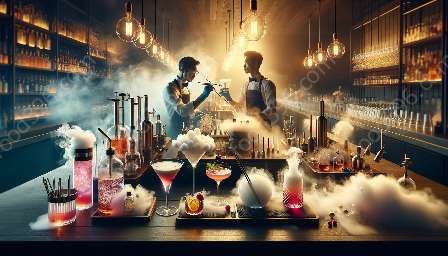Molecular mixology has revolutionized the way cocktails are crafted, introducing innovative techniques and ingredients that push the boundaries of traditional mixology. The fusion of science and mixology has led to the incorporation of molecular ingredients in cocktails, creating unique and captivating libations that excite the senses.
Molecular Mixology and Cocktail Culture
The emergence of molecular mixology has significantly impacted cocktail culture, transforming the way bartenders and mixologists approach drink creation. By integrating scientific principles and molecular gastronomy into mixology, new possibilities have emerged, leading to the creation of visually stunning, multi-sensory cocktails that offer a memorable experience for enthusiasts.
Molecular mixology has transcended traditional mixology techniques by incorporating molecular ingredients such as foams, caviars, gels, and spheres into cocktails. These ingredients are created using scientific processes like spherification, emulsification, and gelification, allowing mixologists to experiment with texture, flavor, and presentation in unprecedented ways.
Exploring Molecular Ingredients
One of the key components of molecular mixology is the use of molecular ingredients to enhance the overall cocktail experience. By utilizing ingredients such as agar-agar, sodium alginate, calcium chloride, and lecithin, mixologists can manipulate the physical and chemical properties of ingredients to create extraordinary effects within each cocktail.
Agar-agar, for example, is a natural gelling agent derived from seaweed, which is used to create firm gels and jellies. Sodium alginate and calcium chloride are essential in the process of spherification, enabling the creation of delicate liquid-filled spheres that burst with flavor when consumed. Additionally, lecithin is utilized to create stable foams that enhance mouthfeel and aroma.
Innovative Techniques and Applications
Beyond the use of molecular ingredients, molecular mixology encompasses a range of innovative techniques that enable mixologists to craft visually striking and flavorful creations. Techniques such as reverse spherification, liquid nitrogen infusion, and vacuum distillation open new avenues for experimentation, allowing for the development of cocktails that challenge traditional notions of mixology.
Reverse spherification involves creating a thin membrane around a flavored liquid, resulting in a delicate and burst-in-the-mouth sensation when consumed. Liquid nitrogen infusion allows for rapid chilling and freezing of ingredients, creating unique textures and dramatic presentations. Vacuum distillation enables the extraction of delicate flavors and aromas from fresh ingredients, offering a new dimension of complexity to cocktails.
Pushing the Boundaries of Mixology
The exploration of molecular ingredients in cocktails represents an exciting frontier in mixology, inviting both professionals and enthusiasts to push the boundaries of creativity and innovation. As molecular mixology continues to influence cocktail culture, the evolution of unique ingredients and techniques will shape the landscape of contemporary cocktails, inspiring a new generation of cocktail enthusiasts to appreciate the artistry and scientific ingenuity behind each libation.
Conclusion
Embracing molecular ingredients in cocktails not only enhances the sensory experience but also celebrates the fusion of science and art in mixology. By exploring the impact of molecular mixology on cocktail culture and delving into innovative techniques and ingredients, enthusiasts can gain a deeper appreciation for the creativity and precision involved in crafting molecular cocktails.

